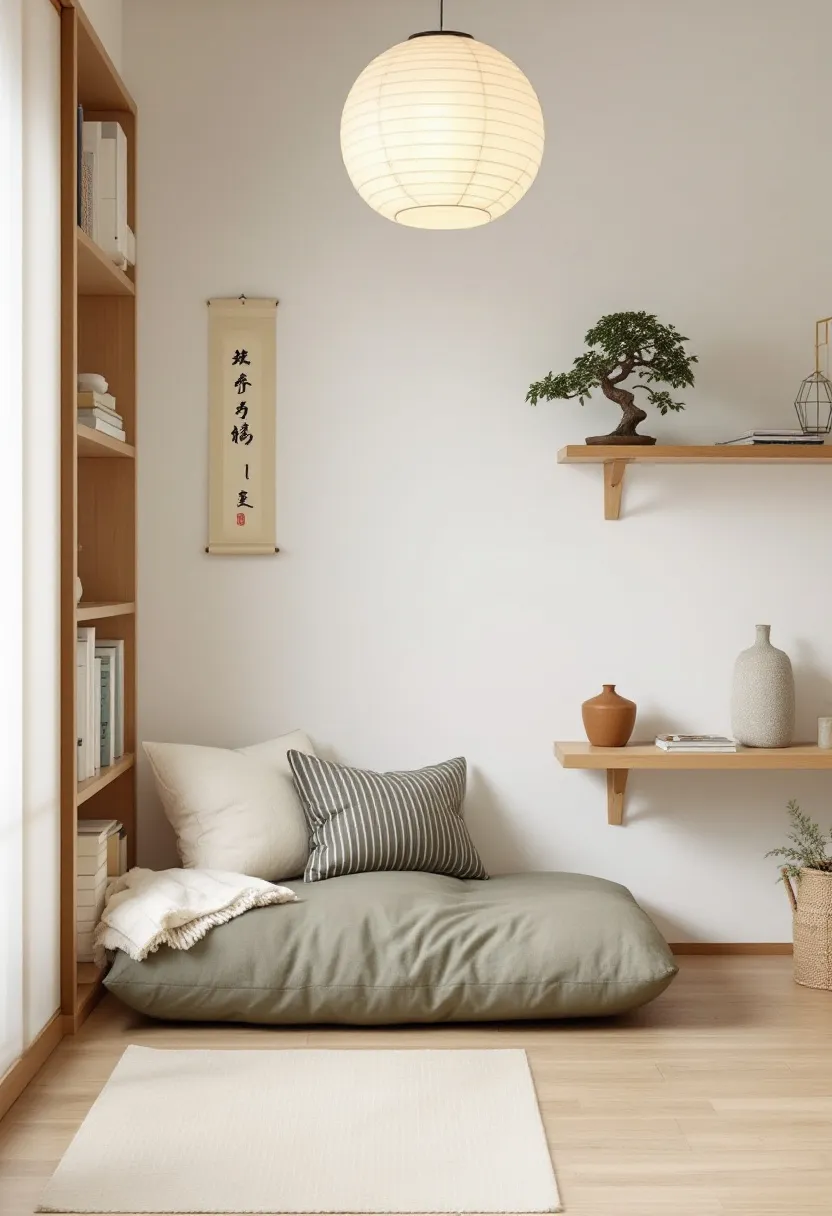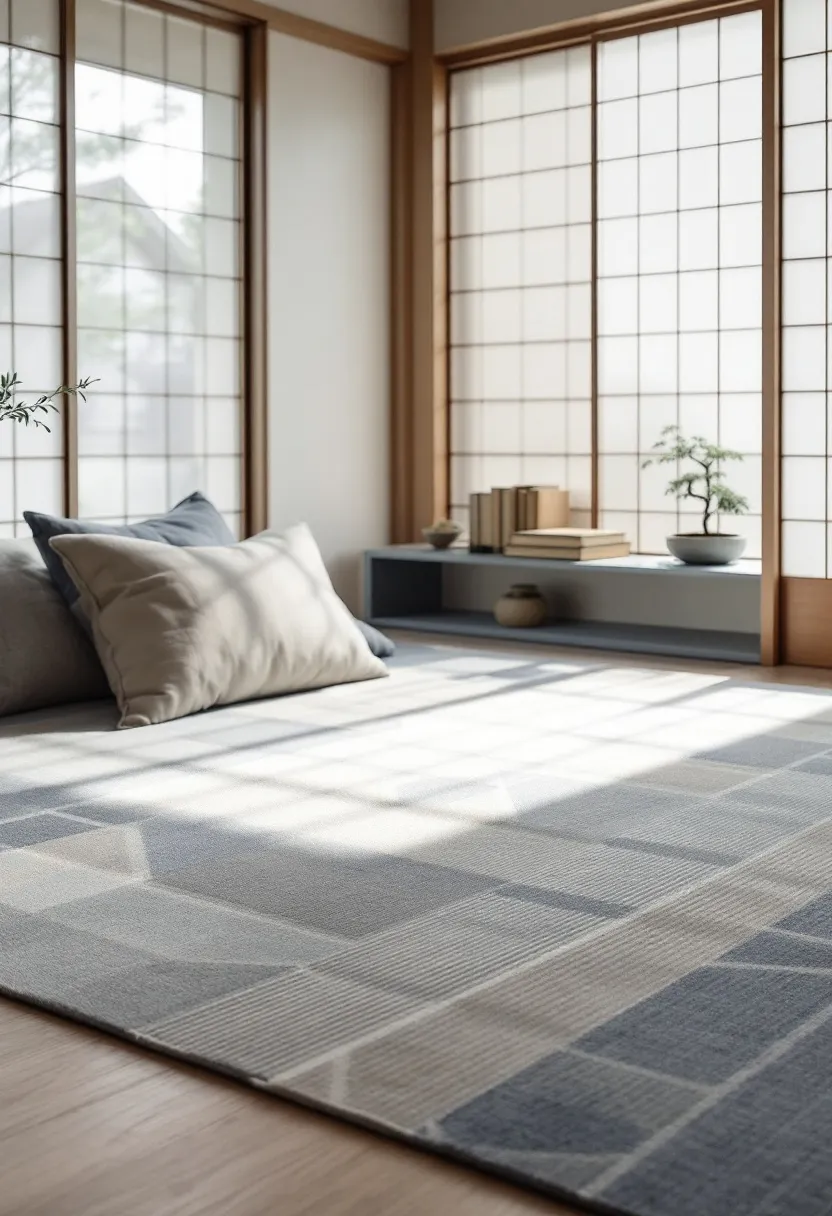
Newsletter Subscribe
Enter your email address below and subscribe to our newsletter

I’ve always been captivated by the serene simplicity of Japanese reading nooks, where every careful design choice creates a sanctuary for literary escape. These inspiring spaces prove that even the smallest corner can become a peaceful retreat, combining natural materials and minimalist elements to craft the perfect reading hideaway. Let me show you twelve stunning transformations that will help you carve out your own quiet corner, complete with practical tips for incorporating authentic Japanese design elements into any space.

A Japanese reading nook creates an inviting sanctuary within your home through the harmonious integration of natural materials like oak and bamboo alongside soft textiles in neutral tones such as slate gray linen upholstery. Carefully selected elements including a minimalist reading chair, paper lantern floor lamp, low bamboo side table, and tatami mat flooring work together to address common challenges in contemporary homes by maximizing small spaces while maintaining an open, uncluttered atmosphere.


Creating this dedicated reading space delivers significant psychological benefits by establishing a clear boundary between work and relaxation zones, allowing your mind to fully disconnect from daily stresses when entering this thoughtfully designed area. The Ultimate Guide To A Modern Japanese Home demonstrates how incorporating shoji screens with landscape artwork, strategically placed bonsai plants, and diffused lighting can transform an ordinary corner into a meditative retreat that promotes mental clarity, deeper reading focus, and a genuine connection to principles of Japanese design philosophy.


A contemporary Japanese reading nook combines built-in seating with natural oak materials, creating a serene retreat that occupies minimal floor space while offering maximum relaxation potential. Such thoughtful design addresses common household challenges of limited square footage and mental clutter by providing a designated space where functionality meets the beautiful art of Japanese colors through muted sage green cushions and natural wood tones.


Creating personal sanctuaries within open floor plans becomes increasingly valuable as modern homes trend toward multifunctional spaces that must serve various needs throughout the day. Soft diffused light from paper lantern pendants paired with tatami mats and minimalist bonsai plants further enhances this purposeful design approach, allowing homeowners to disconnect from digital distractions while maintaining visual harmony with the rest of their living space.


A Japanese Reading Nook creates perfect harmony between thoughtful design and serene functionality through carefully curated elements like tatami mat flooring, shoji screens, and slender paper lantern pendants that cast soft, diffused light across the space. Contemporary wooden side tables crafted from light maple serve dual purposes for both storage and serving, allowing homeowners to maintain minimalist aesthetics while addressing practical needs for organization and convenience.


Creating Calming Japandi Reading Nooks for small spaces transforms otherwise overlooked corners into purposeful retreats where homeowners can disconnect from digital distractions and reconnect with themselves through mindful relaxation or focused reading. Low cushioned seating areas paired with neutral-toned calligraphy scrolls and small bonsai plants not only honor traditional Japanese design principles but also deliver practical benefits like improved focus, reduced visual clutter, and enhanced daily wellness routines without requiring extensive square footage or expensive renovations.


Japanese reading nooks blend natural materials with thoughtful lighting design, creating a peaceful sanctuary where paper lantern pendants and minimalist wall sconces cast a gentle glow over tatami mats and low profile cushioned seating. Incorporating shoji screens alongside natural wood shelving addresses common spatial challenges while providing both storage solutions and visual boundaries that maintain an open feel within your modern farmhouse aesthetic.


Consider how a cozy reading nook transforms otherwise unused corners into functional retreats that encourage daily moments of mindfulness and literary escape amid the chaos of everyday life. From the inclusion of a small bonsai plant bringing living energy to the space, to strategic placement of calligraphy scrolls against neutral earth tones, each element serves both aesthetic and practical purposes while honoring traditional Japanese design principles reimagined for contemporary homes.


A Japanese reading nook creates a peaceful sanctuary through thoughtful integration of natural elements like bamboo shelving, tatami mats, and strategically placed bonsai plants that bring the outdoors inside. Space-saving design solutions including low minimalist seating and built-in shelving address common apartment constraints while providing dedicated areas for literary escape without sacrificing valuable square footage.


Creating contrast between Eastern minimalism and Western coziness allows homeowners to experience the best of both design philosophies while maintaining aesthetic harmony throughout adjacent living spaces. Unlike Charming English Country Reading Nooks which rely heavily on ornate details, Japanese inspired reading corners derive their comfort from clean lines, natural materials, and precise furniture placement that together promote mental clarity and relaxation during reading sessions.


A Japanese reading nook combines essential design elements including textured shoji screens, natural clay plaster walls, and warm cedar panels that create an atmosphere of tranquility while maintaining visual interest through contrasting textures. Thoughtful integration of soft diffused lighting from paper lanterns alongside strategic placement of circular windows overlooking zen gardens addresses common household challenges like inadequate natural light and lack of personal retreat spaces in open floor plans.


Creating cozy reading spaces that welcome quiet moments becomes possible when traditional tatami mats, minimalist bookshelves, and low cushioned benches are arranged to maximize both comfort and functionality within compact spaces. Beyond aesthetic appeal, these intentional design choices promote mindfulness and stress reduction by establishing a dedicated zone that physically separates you from household distractions while surrounding you with natural materials proven to lower cortisol levels and improve focus during reading sessions.


Japanese reading nooks combine minimalist wall treatments such as shoji screens and natural wood slats with ambient lighting from rice paper lanterns to create tranquil spaces perfect for escaping into a good book. These thoughtfully designed retreats address the common challenge of finding peaceful sanctuaries within busy homes, offering low cushioned seating platforms and tatami mats that encourage proper posture during extended reading sessions.


When autumn arrives, creating the perfect fall reading nook becomes especially valuable as cooler temperatures inspire more indoor activities and quiet moments of reflection. Floating bamboo shelves adorned with simple elements like a single bonsai plant or geometric ceramic vase not only maximize limited space but also maintain visual harmony while providing practical storage for seasonal reading materials and personal treasures that enhance your connection to the space.


A Japanese reading nook transforms ordinary corners into sanctuaries of calm through strategic elements like bamboo blinds, tatami mats, and low platform seating that create a defined space within larger rooms. Natural materials throughout these intimate retreats address common household challenges of insufficient relaxation spaces while controlling light through traditional shoji screens that diffuse harsh sunlight into gentle, ambient illumination.


Crafting your own reading sanctuary provides an exceptional opportunity to incorporate elements from traditional Japanese kitchen design concepts while creating a personal refuge that balances functionality with aesthetic harmony. Beyond mere visual appeal, specific design choices like built-in bookshelves maximize limited space efficiency, while carefully positioned plants enhance air quality and create visual connection to nature – making your reading nook both beautiful and beneficial to daily wellbeing.


A Japanese reading nook combines natural materials like tatami mats and bamboo with carefully selected low seating to create a tranquil space that feels both authentically cultural and personally restorative. Flexible floor cushions in muted sage and cream linen provide comfortable seating options while maintaining the clean aesthetic that makes Japanese design so appealing for modern homes seeking simplicity and function.


Consider how classic Japanese dining room designs similarly emphasize connection to nature, minimalism, and thoughtful arrangement of essential elements without excess clutter. Natural diffused light from paper lanterns creates a gentle ambiance that reduces eye strain during extended reading sessions while simultaneously transforming an ordinary corner into a dedicated sanctuary where mindfulness and relaxation become part of your daily routine.


Japanese reading nooks combine minimalist tatami flooring with strategically placed floor cushions and low wooden bookshelves to create peaceful retreats within bustling modern homes. Natural elements like diffused light filtering through shoji screens work harmoniously with geometric patterned rugs in muted grays and soft blues to establish balance between functionality and aesthetic tranquility in your living space.


Creating dedicated reading spaces represents a fundamental principle found in many Japanese hallway design concepts that prioritize intentional transitions between different functional areas of the home. Beyond mere visual appeal, these thoughtfully designed nooks offer practical mental health benefits by providing household members with accessible sanctuaries for daily meditation, reading, or quiet contemplation away from digital distractions and household noise.


A contemporary Japanese reading nook combines minimalist aesthetics with functional elements where soft ambient lighting filters through paper lanterns while tatami mats and floor cushions create an inviting space for relaxation and literary escape. Strategic placement of bamboo shelving units nearby solves storage challenges by keeping favorite books within arm’s reach without contributing to visual clutter that often plagues reading areas in modern homes.


Through thoughtful integration of natural elements like bonsai plants and monochromatic ink landscape paintings, these tranquil spaces promote mental clarity and stress reduction that busy homeowners increasingly prioritize in their self-care routines. Similar principles of balance between functionality and zen-like simplicity found in Japanese bathroom design elements can be incorporated into reading nooks through careful selection of materials that emphasize natural textures, clean lines, and purposeful arrangement of both decorative and practical components.

A Japanese reading nook combines essential elements of tranquility through natural materials like tatami mats, bamboo blinds, and low wooden platforms that create an intentional separation from the busier areas of your home. Incorporating a ceramic pot with a snake plant not only adds visual interest but also naturally purifies your air while requiring minimal maintenance, perfect for busy homeowners who still want a touch of nature in their sanctuary.


Consider exploring additional Japanese bedroom design ideas that balance functionality with the meditative qualities that make these spaces so appealing to modern homeowners. Beyond pure aesthetics, each element serves multiple purposes—the paper screens filter harsh light into a gentle glow that reduces eye strain while reading, while the small water feature introduces gentle background sounds that effectively mask household noise without becoming distracting.


A Japanese reading nook transforms any corner into a serene retreat through the strategic combination of tatami mat flooring, a minimalist bamboo storage ottoman, and the gentle illumination from a paper lantern pendant that casts perfectly diffused light throughout the space. Such thoughtful elements address common household challenges by creating a dedicated space for relaxation while maintaining the clean, uncluttered aesthetic that characterizes authentic Japanese interior design.


Consider how shoji screen dividers not only define your reading nook’s boundaries but also filter natural light, creating that distinctive soft glow that makes Japanese living spaces feel simultaneously airy and intimate. According to Japanese Living Room design philosophy, incorporating natural materials alongside functional pieces like platform seating with hidden storage compartments allows you to maintain a minimalist appearance without sacrificing the practicality needed for everyday living.

